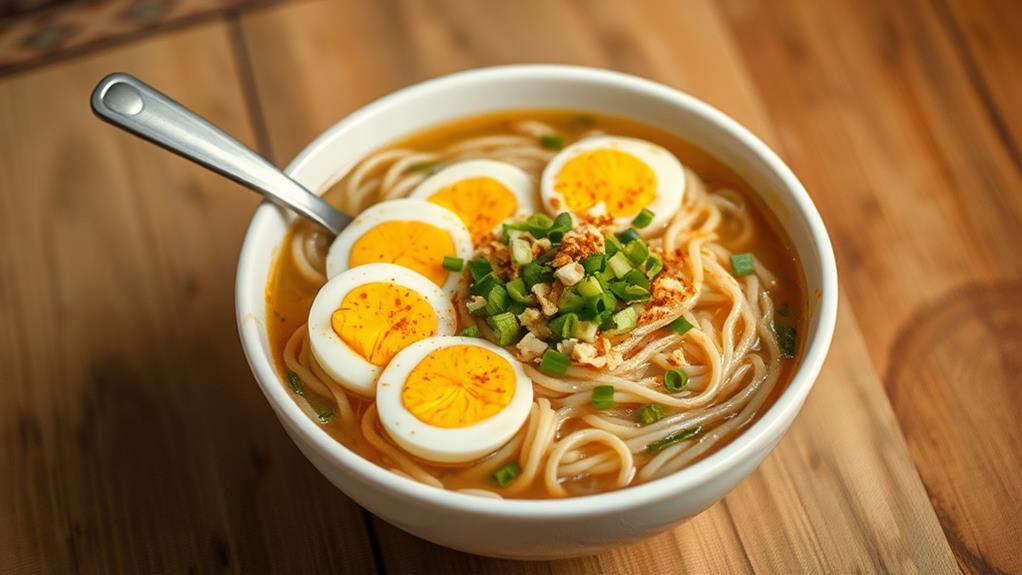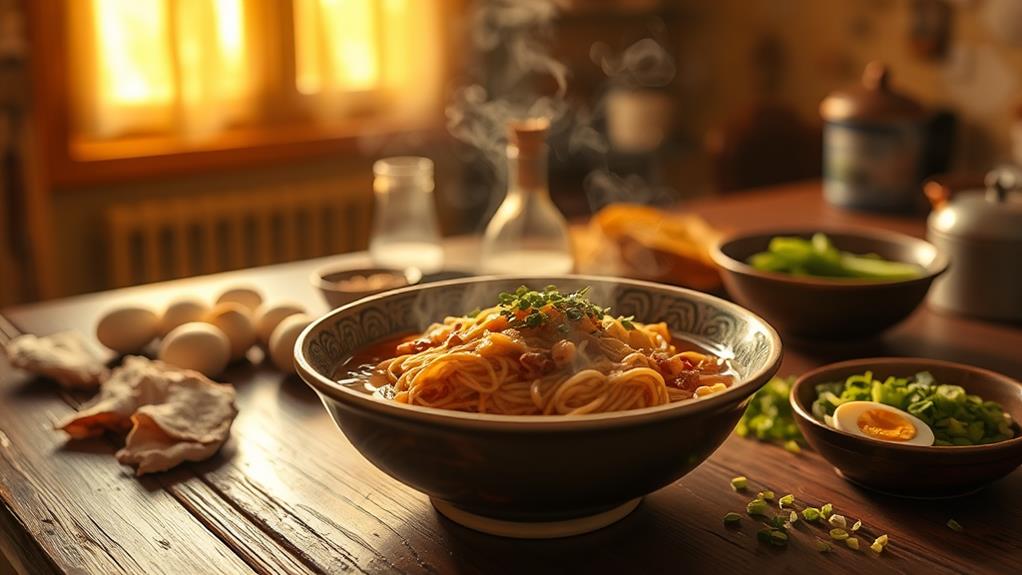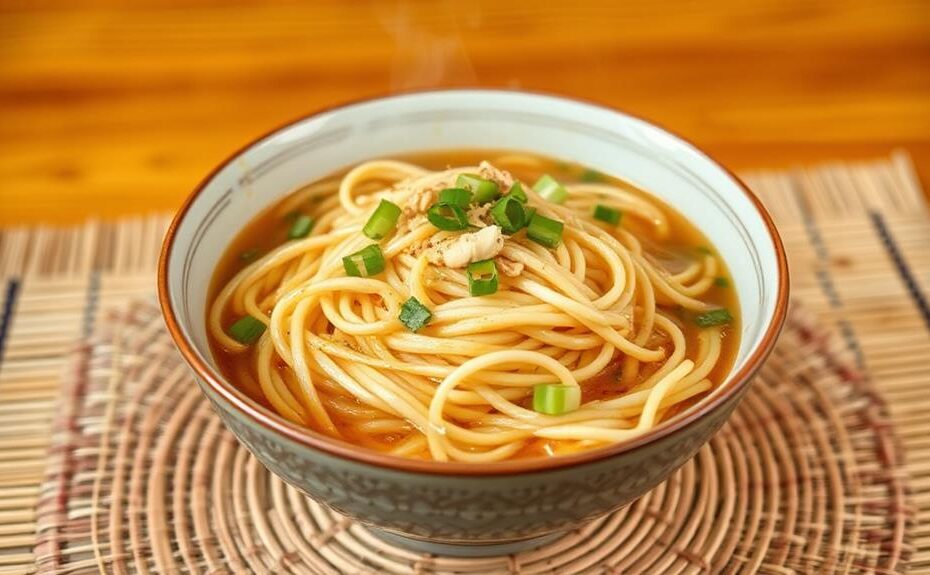Lomi: A Filipino Comfort Food
Pancit Lomi, or simply Lomi, is a beloved Filipino dish that combines thick egg noodles and rich broth, influenced by Chinese cuisine.
Over time, it has evolved into various flavors, making it a staple in many Filipino households.
Three Must-Try Recipes
This article will explore three must-try Lomi recipes that showcase the versatility of this comfort food. From the meaty Batangas Lomi to seafood and vegetarian adaptations, each recipe offers a unique twist on the classic dish.
Traditional Techniques
To create an authentic Lomi experience, it's essential to master traditional techniques.
Sautéing garlic and onions is a crucial step in creating aromatic flavors.
Additionally, adding beaten eggs enriches the broth, giving it a creamy texture.
These techniques are just the beginning of your culinary journey into the world of Lomi.
Exploring the World of Filipino Lomi

Filipino Lomi: A Rich Tapestry of Flavors and Variations
Filipino Lomi, also known as Pancit Lomi, is a beloved dish characterized by its thick egg noodles and rich, flavorful broth, often influenced by Chinese cuisine.
This dish has evolved over time, resulting in a variety of flavors and variations.
Regional Variations
One popular variant is Batangas Lomi, which features a meatier profile with pork belly, squid balls, and liver.
This variation takes the traditional dish to the next level with its hearty ingredients.
Traditional Cooking Methods
Traditional cooking methods involve thickening the soup with a cornstarch slurry and enriching it with beaten eggs to achieve a comforting, savory texture.
This process creates a thick and flavorful broth that's characteristic of Lomi.
Versatility and Adaptability
What's remarkable about Lomi is its versatility, allowing for numerous variations to accommodate diverse dietary preferences.
You can find variations like seafood Lomi, chicken Lomi, and even vegetarian adaptations, all of which are typically enjoyed as a comforting meal.
Serving Traditions
Filipino cuisine has made Lomi a staple, often served with toppings like crispy pork, hard-boiled eggs, and fresh herbs.
These toppings add a burst of flavor and texture to the dish, making it a satisfying meal.
Cooking Up Delicious Lomi Variations
Filipino Lomi offers endless possibilities for creative experimentation in the kitchen. You can customize your lomi soup by choosing from various proteins like pork belly, chicken, shrimp, and squid balls to cater to diverse taste preferences.
The flavorful broth is thickened using a cornstarch slurry, which adds texture and allows the flavors to meld together beautifully, creating a hearty dish.
Traditional toppings enhance the dish's flavor and presentation. Crispy chicharrón, hard-boiled eggs, and scallions are commonly used toppings that make the dish visually appealing.
Regional variations offer different twists on the traditional recipe. For example, Batangas Lomi focuses on a meatier profile and less emphasis on vegetables, while seafood Lomi offers a lighter alternative with crab and squid.
Mastering cooking techniques is key to achieving the perfect lomi texture and flavor. Sautéing garlic and onions for aromatics and carefully adding beaten eggs for richness are essential techniques to master.
What Makes These Filipino Lomi Variations Different from the Traditional Recipes?
Filipino lomi variations taste distinct from the traditional recipes due to their unique blend of seasonings and ingredients. While the traditional lomi boasts a rich and savory flavor, these variations offer a new twist with added spice, sweetness, or tanginess, providing a delightful twist on the classic dish.
Discovering the Flavors of Home

Lomi Soup: A Taste of Home and Tradition
The rich flavors of lomi soup evoke childhood memories of family gatherings and warm moments around the dinner table. This Filipino comfort food is more than just a meal; it's a representation of home and tradition.
A Harmonious Blend of Flavors and Textures
Lomi soup's broth is a combination of pork, squid balls, and fresh egg noodles, creating a harmonious blend of flavors and textures.
The key elements that make lomi soup a true comfort food classic are:
Thick and Satisfying Broth
The broth is thick and slightly slimy, enhanced with cornstarch for a satisfying texture.
Hearty Servings of Protein
Lomi soup features hearty servings of pork belly, squid balls, and liver, adding richness to the dish.
Fresh Egg Noodles
The fresh egg noodles absorb the flavorful broth perfectly.
Customizable with Optional Toppings
Optional toppings like crispy chicharrón, hard-boiled eggs, and seasonal vegetables allow each bowl to be unique.
The Love and Care of Cooking from Scratch
Lomi soup is often cooked from scratch, strengthening family bonds through shared culinary experiences.
Frequently Asked Questions
Is Lomi Filipino or Chinese?
Lomi is a dish with Chinese roots that has become a beloved part of Filipino culture.
Lomi's origins are rooted in Chinese cuisine, specifically the Hokkien dish Lor Mee. However, over time, it evolved in the Philippines, particularly in Batangas, where it took on a life of its own.
In the Philippines, Lomi developed unique regional variations and distinct ingredients, such as thick egg noodles and pork. This cultural adaptation has given Lomi a rich cultural significance that's undoubtedly Filipino.
What to Pair With Lomi?
Balancing Flavors with Lomi
When pairing with lomi, it's essential to balance its richness with contrasting flavors and textures. Crispy lechon kawali or lumpiang shanghai provide a satisfying crunch, while pickled vegetables like atsara or a squeeze of calamansi juice offer a refreshing twist.
Customizing Lomi with Toppings and Sauces
Hard-boiled eggs and sliced green onions make great lomi toppings, adding texture and flavor.
A side of patis or fish sauce can enhance the broth, providing an added layer of flavor.
Beverage Pairings for Lomi
Iced tea or buko juice are excellent beverage pairings for lomi, offering a refreshing contrast to the rich noodles.
Experiment with different options to find your perfect match!
What Makes Batangas Lomi Special?
Batangas Lomi's Unique Flavor Profile
Batangas Lomi stands out from other regional variations due to its rich and harmonious blend of flavors. This is achieved through the use of a cornstarch slurry that adds depth to the broth.
Traditional Ingredients and Cooking Techniques
The dish features local ingredients like miki noodles, which provide a unique texture. The use of minimal veggies allows the meat flavors to shine, making each bite savory and satisfying.
Traditional cooking techniques passed down through family recipes and serving traditions contribute to the dish's cultural significance.
Cultural Significance
Batangas Lomi is more than just a meal; it's a taste of cultural heritage that evokes a sense of tradition and community. Its significance is rooted in the family recipes and serving traditions that have been preserved and passed down through generations.
What Is the Difference Between Lomi and Mami?
The noodles, broth, and flavors differentiate Lomi from Mami.
Lomi features thick egg noodles that absorb a rich, cornstarch-thickened broth loaded with meats and seafood.
In contrast, Mami has wheat noodles swimming in a lighter, clearer broth with fewer ingredients.
Regional Lomi variations, such as Batangas Lomi, boast hearty meat profiles.
On the other hand, Mami often features chicken or beef.
The texture, toppings, and flavors of Lomi and Mami differ, making each a unique Filipino culinary experience.
